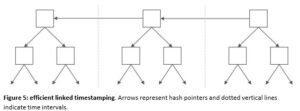Another key component of Bitcoin is the block chain: a ledger in which all Bitcoin transactions are securely recorded. The ideas behind the block chain are again quite old, and trace back to a paper by Haber and Stornetta in 1991. Their proposal was a method for secure timestamping of digital documents, rather than an digital money scheme. The goal of timestamping is to give an approximate idea of when a document came into existence. More importantly, timestamping accurately conveys the order of creation of these documents: if one came into existence before the other, the timestamps will reflect that. The security property requires that a document’s timestamp can’t be changed after the fact.
In Haber and Stornetta’s scheme, there’s a timestamping service to which clients send documents to timestamp. When the server receives a document, it signs the document together with the current time and as well as a link or a pointer to the previous document, and issues a “certificate” with this information. The pointer in question a special type pointer which links to a piece of data instead of a location. That means that if the data in question changes, the pointer automatically become invalid. In Chapter 1 we’ll study how we can create such pointers using hash functions.
What this achieves is that each document’s certificate ensures the integrity of the contents of the previous document. In fact, you can apply this argument recursively: each certificate essentially fixes the entire history of documents and certificates up until that point. If we assume that each client in the system keeps track of at least a few certificates — their own documents’ certificates, and those of the previous and following documents — then collectively the participants can ensure that the history cannot be changed after the fact. In particular, the relative ordering of documents is preserved.

A later paper proposed an efficiency improvement: instead of linking documents individually, we can collect them into blocks and link blocks together in a chain. Within each block, the documents would again be linked together, but in a tree structure instead of linearly. This decreases the amount of checking needed to verify that a particular document appears at a particular point in the history of the system. Visually, this hybrid scheme looks like Figure 5.

This data structure forms the skeleton of Bitcoin’s block chain, as we’ll see in Chapter 3. Bitcoin refines it a subtle but important way: a Hashcash-esque protocol is used to delay how fast new blocks are added to the chain. This modification has profound and favorable consequences for Bitcoin’s security model. There is no longer the need for trusted servers; instead, events are recorded by a collection of untrusted nodes called “miners”. Every miner keeps track of blocks, rather than having to rely on regular users to do it. Anyone can become a miner by solving computational puzzles to create blocks. Bitcoin also gets rid of signatures, relying only on hash pointers to ensure the integrity of the data structure. Finally, the actual timestamps aren’t of much importance in Bitcoin, and the point of the system is to record the relative ordering of transactions in a tamper-resistant way. In fact, Bitcoin blocks aren’t created in a fixed schedule. The system ensures that a new one is created every 10 minutes on average, but there’s considerable variation in the time between successive blocks.
In essence, Bitcoin combines the idea of using computational puzzles to regulate the creation of new currency units with the idea of secure timestamping to record a ledger of transactions and prevent double spending. There were earlier, less sophisticated proposals that combined these two ideas. The first is called b-money, and it was by Wei Dai in 1998. In b-money, anyone can create money using a hashcash-like system. There’s a peer-to-peer network, sort of like in Bitcoin. Each node maintains a ledger, but it’s not a global ledger like in the Bitcoin block chain. Each node has its own ledger of what it thinks everyone’s balance is.
Another similar proposal, by Nick Szabo, is called Bitgold. Szabo says he had the idea for Bitgold as early as 1998, but didn’t get around to blogging about it until 2005. The reason I mention this is that there’s a minor conspiracy theory popularized by Nathaniel Popper, a New York Times reporter who wrote a very good book on the history of Bitcoin. Popper notes that the blog post timestamps were changed after Satoshi posted the Bitcoin whitepaper so that the Bitgold proposal looks like it was written up about two months after Bitcoin was released. Popper believes, like many other observers, that Szabo could be Satoshi, and he cites the timestamp change as evidence of Szabo/Satoshi trying to cover up the fact that he invented Bitgold before he knew about Bitcoin.
The problem with this explanation is that if you actually read the contents of the blog posts, Szabo is very clear about having had this idea in 1998, and he doesn’t try to change those dates. So a more reasonable explanation is that he just bumped the post to the top of his blog after Bitcoin popularized similar ideas, to make sure that people were aware of his prior proposal.
Bitcoin has several important differences from b-money and Bitgold. In those proposals, computational puzzles are used directly to mint currency. Anyone can solve a puzzle and the solution is a unit of money itself. In Bitcoin, puzzle solutions themselves don’t constitute money. They are used to secure the block chain, and only indirectly lead to minting money for a limited time. Second, b-money and Bitgold rely on timestamping services that sign off on the creation or transfer of money. Bitcoin, as we’ve seen, doesn’t require trusted timestamping, and merely tries to preserve the relative order of blocks and transactions.
Finally, in b-money and Bitgold, if there is disagreement about the ledger among the servers or nodes, there isn’t a clear way to resolve it. Letting the majority decide seems to be implicit in both authors’ writings. But since anyone can set up a node — or a hundred, hiding behind different identities — these mechanisms aren’t very secure, unless there is a centralized gatekeeper who controls entry into the network. In Bitcoin, by contrast, for an attacker to change history, they must solve computational puzzles at a faster rate than the rest of the participants combined. This is not only more secure, it allows us to quantify the security of the system.
B-money and Bitgold were informal proposals — b-money was a post on a mailing list and Bitgold was a series of blog posts. Neither took off, or was even implemented directly. Unlike the Bitcoin white paper, there wasn’t a full specification or any code. The proposals gloss over issues that may or may not be solvable. The first, as we’ve already mentioned, is how to resolve disagreements about the ledger. Another problem is determining how hard the computational puzzle should be in order to mint a unit of currency. Since hardware tends to get dramatically cheaper over time for a fixed amount of computing power, Bitcoin incorporates a mechanism to automatically adjust the difficulty of the puzzles periodically. B-money and Bitgold don’t include such a mechanism, which can result in problems since coins may lose their value if it become trivially easy to create new ones.

































